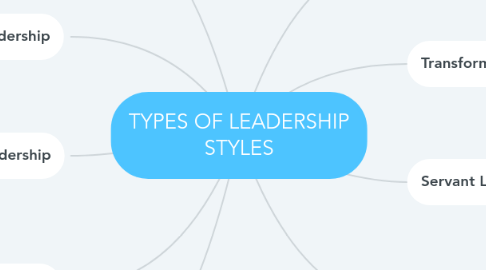
1. Democratic Leadership
1.1. These leaders ask for input from others before making decisions.
1.1.1. Pros
1.1.1.1. Allows employees to feel heard and as if their contributions matter; Often leads to a higher level of employee engagement; Great for creativity and innovation
1.1.2. Cons
1.1.2.1. They can lead to a delay in decision making. also, they can leave employees feeling uncertain if their leaders need to make a quick decision and do not consult with them first
2. Bureaucratic Leadership
2.1. Demonstrates strict adherence to rules and regulations. Bureaucratic leaders are very “by the books.”
2.1.1. Pros
2.1.1.1. Very effective in highly regulated environments, such as government and finance
2.1.2. Cons
2.1.2.1. Limited collaboration and creativity
3. Coaching Leadership
3.1. Coaching leaders excel at connecting people’s personal goals with the goals of the organization. They focus on developing others and are emphatic and encouraging.
3.1.1. Pros
3.1.1.1. Advantageous for employers and employees; Sets clear expectations for employees; Promotes a positive and motivating work environment
3.1.2. Cons
3.1.2.1. Time-intensive on behalf of the employees and the leaders
4. Transactional Leadership
4.1. They are focused on performance and establish incentives for employees. These leaders value mentorship and training to achieve their predetermined goals.
4.1.1. Pros
4.1.1.1. Drives teams and organizations to achieve their goals; Sets clear expectations for employees roles and responsibilities
4.1.2. Cons
4.1.2.1. Does not promote creativity among employees; Can encourage employees to complete the bare minimum
5. Pacesetting Leadership
5.1. They focus is driving performance. They have high standards and hold their team accountable for hitting goals. These leaders are motivational and serve to energize their teams.
5.1.1. Pros
5.1.1.1. Effective for driving fast results
5.1.2. Cons
5.1.2.1. Does not work well for employees who need mentorship; Can lead to a stressful work environment
6. Autocratic Leadership
6.1. They are known for making decisions alone or with little input from others. This type of leader expects employees to do exactly as they’re asked.
6.1.1. Pros
6.1.1.1. Can be beneficial in organizations with strict compliance guidelines.
6.1.2. Cons
6.1.2.1. Can hinder creativity among employees and make them feel restricted
7. Transformational Leadership
7.1. They are driven by a commitment to an organization's objectives. They inspire staff by fostering an environment of intellectual stimulation and often delegate many tasks.
7.1.1. Pros
7.1.1.1. Great for inspiring employees and motivating them to get out of their comfort zones
7.1.2. Cons
7.1.2.1. Is likely not to work well when employees require more supervision;
8. Servant Leadership
8.1. They value a collaborative approach and encourage collective decision making. This leadership style typically receives high levels of respect and is a strong leadership style among nonprofit organizations.
8.1.1. Pros
8.1.1.1. High levels of employee morale and employee engagement
8.1.2. Cons
8.1.2.1. It may take longer to make decisions and leaders may be seen as not having formal authority to get the job done
9. Visionary Leadership
9.1. Visionary leaders inspire employees and drive progress, especially during periods of change. They can establish strong bonds in an organization and boost confidence among employees. These leaders understand the big picture and can create a long-term vision for the company.
9.1.1. Pros
9.1.1.1. Fosters innovation and creativity; Most effective for fast-growing organizations and organizations looking to restructure
9.1.2. Cons
9.1.2.1. Less emphasis on the small details and day-to-day operations; Lack of accountability among employees

